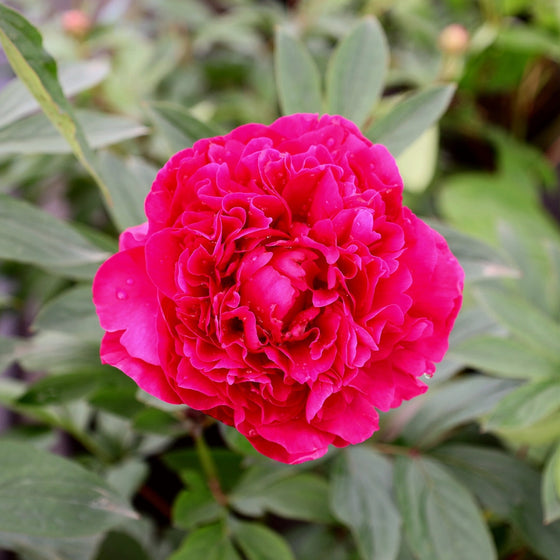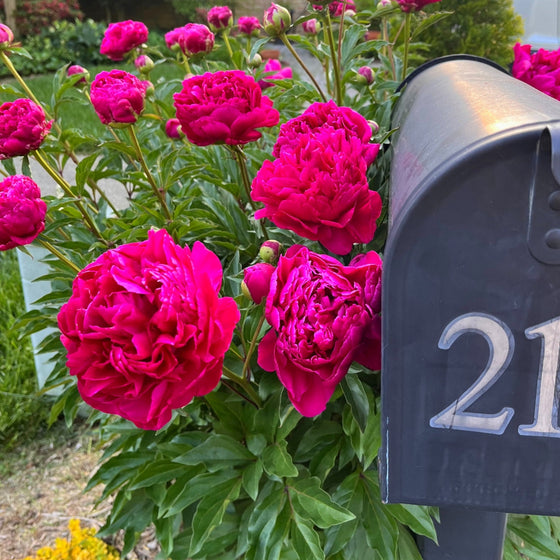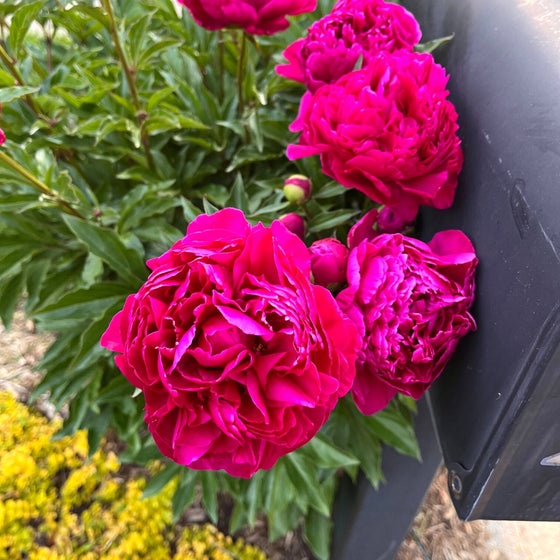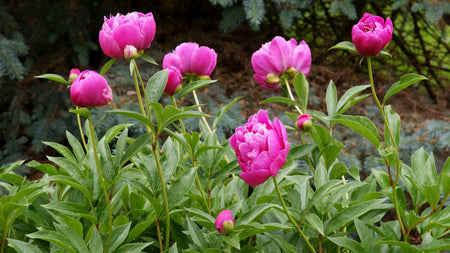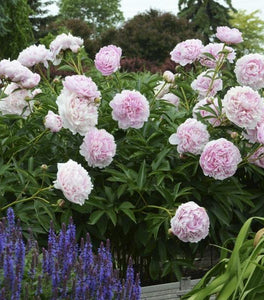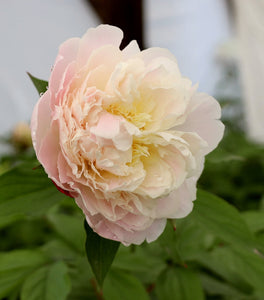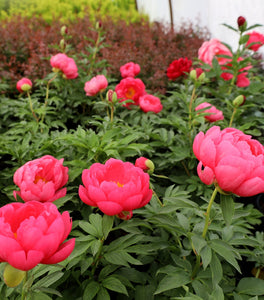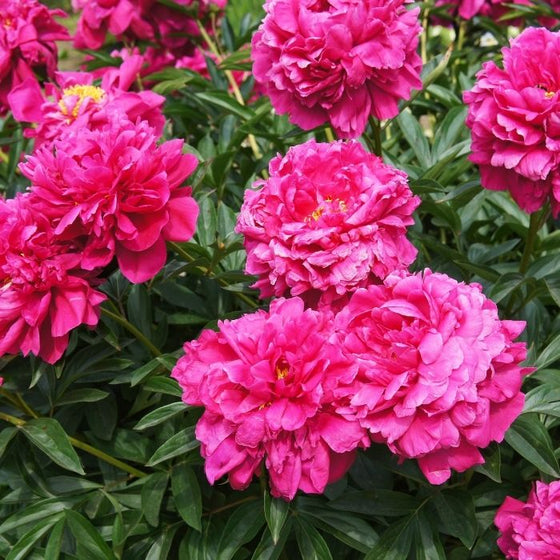
Images Depict Mature Plants
Kansas Peony Plants
Kansas Peony (Paeonia lactiflora ‘Kansas’) is a bold, award-winning perennial prized for its rich, double, ruby-red blooms and upright, vigorous growth habit. Blooming in late spring to early summer, this herbaceous peony produces large, fully double flowers with a velvety texture and a brilliant hue that intensifies as the blooms mature. Its vibrant color and lush foliage make it a stunning focal point in borders, cottage gardens, and classic perennial beds, while the long-lasting flowers also make excellent additions to fresh floral arrangements.
Growing up to 3 feet tall and wide, Kansas Peony thrives in full sun and well-drained, fertile soil. Once established, it is remarkably low-maintenance and long-lived, often returning stronger year after year with minimal care. This variety features strong stems that hold up the large blossoms beautifully, reducing the need for staking and making it a practical choice for both formal and naturalistic garden designs. Deer and rabbit resistant, the plant’s deep green foliage remains attractive throughout the growing season, even after the bloom period has ended.
Perfect for cutting gardens, foundation plantings, or standalone specimens, Kansas Peony brings unmatched color intensity and classic charm to the landscape. Its bright crimson blooms attract pollinators and create a striking contrast when paired with pastel-colored perennials like lavender, iris, or foxglove. Whether you’re designing a traditional flower garden or seeking a bold accent in a sunny perennial border, Kansas Peony delivers reliable beauty, elegance, and garden performance year after year.

| Hardiness Zone: | 3-8 |
|---|---|
| Mature Height: | 30 to 36 Inches |
| Mature Width: | 2 to 3 Feet |
| Sunlight: | Full sun |
| Water Requirements: | Water well until established |
| Flower Color: | Bright red double form |
| Details: | Bright red flowers, fragrant, good cut flower |
How to Care for Kansas Peony
Be sure to read our planting instructions to ensure a healthy and happy Kansas Peony plant for years to come!
How Should I Plant my Potted Kansas Peony Plants?
To plant your potted Kansas Peony successfully, choose a location that receives full sun (at least 6 hours daily) and offers rich, well-drained soil. Begin by digging a hole twice as wide as the pot and just as deep, ensuring the top of the root ball will be level with the surrounding ground. Gently remove the peony from its container, loosen any circling roots, and place it in the hole. Backfill with a mix of native soil and compost, pressing firmly around the base to eliminate air pockets. Water thoroughly after planting to help the roots settle and begin establishing in their new location. Space Kansas Peony plants about 3 feet apart to allow for mature growth and good air circulation, which helps prevent common fungal issues like powdery mildew. Avoid planting too deep, as peonies need the crown and buds close to the soil surface to bloom properly. After planting, apply a light mulch layer to retain moisture and suppress weeds, keeping the mulch a few inches away from the crown to prevent rot. With proper planting and care, your potted Kansas Peony will reward you with large, velvety red blooms and lush foliage that return reliably each spring.
How Should I water my Kansas Peony Plants?
Watering your potted Kansas Peony plants correctly is essential to ensure strong root development and healthy blooms. During the first growing season, keep the soil consistently moist but not waterlogged, checking the top 1–2 inches of soil regularly. Container-grown peonies dry out more quickly than those planted in the ground, especially in sunny locations, so they may need watering every few days during hot or dry weather. Use a watering can or hose to soak the soil deeply at the base of the plant, avoiding overhead watering to prevent fungal issues on the foliage. Once established, continue to water your potted Kansas Peony whenever the soil begins to feel dry to the touch. Make sure the container has excellent drainage to prevent root rot, and avoid letting the pot sit in standing water. Adding a layer of mulch on top of the soil can help retain moisture and keep the root zone cool, especially in warmer climates. Proper watering ensures lush foliage, strong stems, and the vibrant ruby-red blooms Kansas Peonies are known for, keeping your container garden both healthy and showy all season long.
How Should I Fertilize my Kansas Peony Plants?
Fertilizing your potted Kansas Peony plants is key to promoting strong growth, vibrant ruby-red blooms, and overall plant health. Begin by applying a balanced, slow-release fertilizer—such as a 10-10-10 or 5-10-5 blend—in early spring as new shoots begin to emerge. Sprinkle the fertilizer evenly around the base of the plant, avoiding direct contact with the crown, and water thoroughly to help nutrients reach the roots. Because nutrients leach more quickly from pots than garden soil, container-grown peonies may benefit from a second light feeding in midsummer to maintain vigor throughout the season. In addition to synthetic fertilizers, organic options like compost tea, fish emulsion, or a top dressing of well-aged compost can provide a steady supply of nutrients while improving soil health. Avoid high-nitrogen fertilizers, as they may promote leafy growth at the expense of flowers. Be cautious not to over-fertilize, which can lead to salt buildup and stress the plant. With the right fertilization schedule and proper care, your potted Kansas Peony will thrive, producing stunning double blooms and lush green foliage year after year in patio containers, entryway planters, or balcony gardens.

How and When Should I Prune my Kansas Peony Plants?
Pruning your Kansas Peony plants at the right time is essential for maintaining plant health and encouraging vigorous blooms each spring. The primary time to prune is in the fall, after the foliage has naturally died back due to frost. Cut the stems down to about 1 to 2 inches above the ground using clean, sharp pruners, and remove all dead leaves and debris from around the plant. This fall cleanup helps prevent overwintering pests and fungal diseases like botrytis, setting the stage for healthy new growth in the next season. During the growing season, deadheading spent blooms can help redirect the plant’s energy back into the roots rather than seed production. While this won’t necessarily encourage reblooming, it keeps the plant looking tidy and may improve overall vigor. Avoid cutting back or pruning in early spring before the plant has emerged, as this can damage new buds. With proper seasonal pruning, Kansas Peonies will continue to deliver lush green foliage and large, double ruby-red blooms year after year in borders, cutting gardens, and foundation planting

